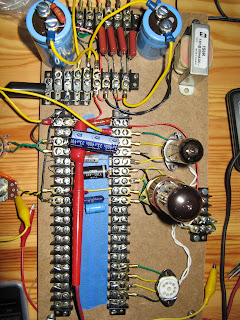Since designing an amp requires lots of iterative suck-it-and-see (as the British say), I decided I needed a quick and easy way to make circuit changes. I considered using a bread board, but those aren't usually rated for more than 120 volts and mine will be running about 300 volts. My father often used barrier strips for experimenting and I happened to have about 10 of his old bakelite strips from the 50's. I mounted those to a piece of Masonite, added 4 feet and I had my prototyping board. The screw heads make it fairly easy to swap components. Here's my first working single channel amp showing the power conditioning (top), a 6SN7 driver (large tube) and a EL84 power tube (smaller tube).
That prototype was a bit low powered and had quite a bit of midrange distortion. I soon was on a quest for a set of tubes which would suit my needs better.
In spring of 2010, I rekindled my love for vacuum tube audio. I built a tube hybrid headphone amp based on an open source design and it sounded amazing. By summer, I started designing and prototyping a tube based hi-fi power amp from scratch - No borrowed schematics just classic techniques, math, CAD and trial & error (see 2010 postings). To log my daily progress, lessons, and results, a blog seems to be a natural tool. If you find it interesting - cool! If not, well, go back to Facebook.
Saturday, July 17, 2010
Thursday, July 1, 2010
Power Amp Design Goals
To avoid analysis paralysis and getting stuck trying to design an amp that's all things to all people, I realized I needed to formalize my design goals.
Also, I'm building at least one of these amps for my friend who will be living off the grid via photovoltaic solar in New Mexico. I'd like this amp to make as little of a dent in his daily collection of power as possible.
- Class A, Single Ended design
- Output: > 3 Watts per channel
- Overall power consumption: < 50 Watts
- Heater power consumption: < 20 Watts (6B4G: 2 x 6.3 = 12.6 Watts)
- THD (total harmonic distortion): < 5% (ideally < 3%)
- Power tube cost: < $70 each (rules out 300B, 45, etc.)
- And of course, amazing sound
Also, I'm building at least one of these amps for my friend who will be living off the grid via photovoltaic solar in New Mexico. I'd like this amp to make as little of a dent in his daily collection of power as possible.
Subscribe to:
Posts (Atom)
